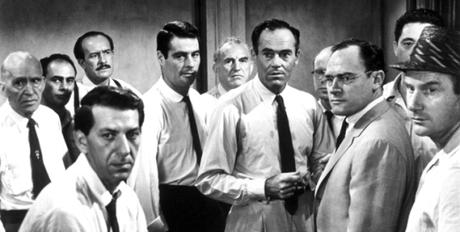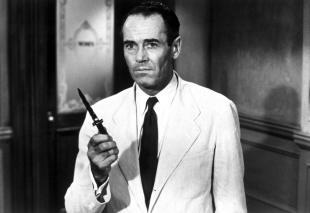 Twelve Angry Men (1957)
Twelve Angry Men (1957)A powerful look into the American criminal justice system and the mysterious ways of jury deliberation and manipulation, the much lauded movie of Twelve Angry Men starring Henry Fonda, E.G. Marshall, Lee J. Cobb and others was director Sidney Lumet’s first foray into the world of first-run cinema.
The story was based on writer and producer Reginald Rose’s Emmy-winning teleplay of the same name, which he developed for the CBS anthology series Studio One. Rose, who created and wrote the successful TV series The Defenders (which also starred E.G. Marshall), had himself served on a trial jury; both the play and the subsequent movie version were taken from his personal experiences of that life-altering event.

Although Lumet was a product of the off-Broadway theater circuit (he was a co-founder of the famous Actor’s Studio), he was also a pioneer of early television, having worked on a variety of network programming and TV shows, among them You Are There, Playhouse 90, Kraft Television Theatre, and the ubiquitous Studio One. The tensions that pervade the ninety-six-minute Twelve Angry Men derive principally from a critical plot element whereby the twelve jurors are charged with deciding the fate of a disadvantaged product of an inner-city slum tenement.
The defendant, a teenager of Hispanic origin, is alleged to have stabbed his father to death after a particularly loud argument. The jurors involved in deciding the case comprise a cross-section of familiar character “types,” each with their own viewpoint based on their individual backgrounds and biases: the bleeding-heart liberal (Henry Fonda), the coldly analytical broker (E.G. Marshall), the narrow-minded bigot (theater veteran Ed Begley), the self-made businessman and troubled parent (Actor’s Studio alumni Lee J. Cobb), the endlessly patient jury foreman (Martin Balsam), the mousy bank employee (John Fiedler, the voice of Piglet in Disney’s Winnie the Pooh), the streetwise ex-ghetto inhabitant (Jack Klugman), the chronically indecisive ad man (clueless Robert Webber), the ethnic immigrant (George Voskovec), the common working stiff (Edward Binns), the apathetic sports nut (Jack Warden), and the wise old man (Joseph Sweeney).

As the jurors begin their deliberation, the lone holdout, known only as Juror #8 (Fonda), voices a reasonable doubt as to the boy’s guilt. Claiming the prosecution’s case is based primarily on circumstantial evidence (which it is), Juror #8 slowly and methodically builds a case of his own for the defendant’s innocence. The movie takes the juror’s theory and follows it to a startling and incredibly revelatory conclusion. Despite a few lapses in logic, including a controversial move by Fonda involving the weapon used to commit the crime — inadmissible if this had been a real-life case — the theatrical structure and (basically) one-room setting are unique to films.
Along with director Otto Preminger’s Anatomy of a Murder from 1959, another entertaining, highly adult, almost clinical dissection of a rape and murder case, Twelve Angry Men was deservedly honored in 2007 for inclusion into the National Film Registry. To this day, Lumet’s maiden achievement on film is used in law schools, universities and criminal justice classes as a textbook example of what juries go through in arriving at a life or death decision.
One must also mention the claustrophobic environment throughout, thanks mainly to Boris Kaufman’s black-and-white cinematography and the low camera angles. A five-star production hands down, this feature is as relevant today as it was back in 1957— maybe more so!
Updated and remade in 1997, this so-called modern adaptation starred Jack Lemmon, George C. Scott, Tony Danza, Courtney B. Vance, Ossie Davis, Hume Cronyn, Dorian Harewood, Edward James Olmos, James Gandolfini, Armin Mueller-Stahl, William Petersen, and Mykelti Williamson as the jurors. Part of the “fun” of this later version, which is several notches below the excellence of the original, is seeing who got which roles in comparison to its predecessor. Check it out and see for yourself!
Copyright © 2015 by Josmar F. Lopes

